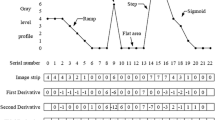Abstract
Gabor wavelet transform is one of the most effective texture feature extraction techniques and has resulted in many successful practical applications. However, real-time applications cannot benefit from this technique because of the high computational cost arising from the large number of small-sized convolutions which require over 10 min to process an image of 256 × 256 pixels on a dual core CPU. As the computation in Gabor filtering is parallelizable, it is possible and beneficial to accelerate the feature extraction process using GPU. Conventionally, this can be achieved simply by accelerating the 2D convolution directly, or by expediting the CPU-efficient FFT-based 2D convolution. Indeed, the latter approach, when implemented with small-sized Gabor filters, cannot fully exploit the parallel computation power of GPU due to the architecture of graphics hardware. This paper proposes a novel approach tailored for GPU acceleration of the texture feature extraction algorithm by using separable 1D Gabor filters to approximate the non-separable Gabor filter kernels. Experimental results show that the approach improves the timing performance significantly with minimal error introduced. The method is specifically designed and optimized for computing unified device architecture and is able to achieve a speed of 16 fps on modest graphics hardware for an image of 2562 pixels and a filter kernel of 322 pixels. It is potentially applicable for real-time applications in areas such as motion tracking and medical image analysis.





Similar content being viewed by others
References
Ahmadian, A., Mostafa, A.: An efficient texture classification algorithm using Gabor wavelet. In: Proceedings of the 25th Annual International Conference of the IEEE Engineering in Medicine and Biology Society, pp. 930–933. New York (2003)
Areekul, V., Watchareeruetai, U., Tantaratana, S.: Fast separable Gabor filter for fingerprint enhancement. In: Biometric Authentication, Lecture Notes in Computer Science, vol. 3072, pp. 1–42. Springer, Berlin (2004)
Brodatz, P.: Textures: A Photographic Album for Artists and Designers. Dover, New York (1996)
Daugman, J.: Two-dimensional spectral analysis of cortical receptive field profiles. Vis. Res. 20(10):847–856 (1980)
Fialka, O., Cadik, M.: FFT and convolution performance in image filtering on GPU. In: Proceedings of the Conference on Information Visualization, pp. 609–614. IEEE Computer Society Press (2006)
Geusebroek, J.M., Smeulders, A., van de Weijer, J.: Fast anisotropic gauss filtering. IEEE Trans. Image Process. 12(8):938–943 (2003). doi:10.1109/TIP.2003.812429
Gool, L.V., Dewaele, P., Oosterlinck, A.: Texture analysis anno 1983. Comput. Vis. Graph. Image Process. 29:336–357 (1985)
Haralick, R.: Statistical and structural approaches to textures. In: Proceedings of the IEEE, vol. 67, pp. 786–804. IEEE (1979)
Haralick, R.M., Shanmugam, K., Dinstein, I.: Textural features for image classification. IEEE Trans. Syst. Man Cybern. 3(6):610–621 (1973)
Harris, M.: Optimizing parallel reduction in cuda. NVIDIA Developer Technology (2008)
Kubota, T.: Orientational filters for real-time computer vision problems. Ph.D. Thesis. Georgia Institute of Technology, Atlanta (1995)
Manjunath, B.S., Ma, W.Y.: Texture features for browsing and retrieval of image data. IEEE Trans. Pattern Anal. Mach. Intell. 18(8):837–842 (1996)
Martin, D., Fowlkes, C., Tal, D., Malik, J.: A database of human segmented natural images and its application to evaluating segmentation algorithms and measuring ecological statistics. In: Proceedings of the 8th International Conference on Computer Vision, vol. 2, pp. 416–423 (2001)
Podlozhnyuk, V.: Image convolution with cuda. NVIDIA Whitepaper (2007)
Reed, T.R., du Buf, J.M.H.: A review of recent texture segmentation and feature extraction techniques. CVGIP Image Underst. 57(3):359–372 (1993)
Treitel, S., Shanks, J.: The design of multistage separable planar filters. IEEE Trans. Geosci. Electron. 9(1):10–27 (1971)
Tuceryan, M., Jain, A.K.: Texture analysis. In: The Handbook of Pattern Recognition and Computer Vision. World Scientific Publishing Co. (1998)
Turner, M.R.: Texture discrimination by Gabor functions. Biol. Cybern. 55(2-3):71–82 (1986)
Wang, X., Shi, B.: GPU implementation of fast Gabor filters. In: Proceedings of 2010 IEEE International Symposium on Circuits and Systems (ISCAS), pp. 373–376 (2010)
Young, I., van Vliet, L., van Ginkel, M.: Recursive Gabor filtering. IEEE Trans. Signal Process. 50(11):2798–2805 (2002)
Acknowledgments
This work is supported in part by the Hong Kong Research Grants Council (No. PolyU 5134/12E). We are grateful to Mr. Marty Lai, radiographer of the Prince of Wales Hospital, and his colleagues for evaluating the results produced in the study.
Author information
Authors and Affiliations
Corresponding author
Rights and permissions
About this article
Cite this article
Pang, WM., Choi, KS. & Qin, J. Fast Gabor texture feature extraction with separable filters using GPU. J Real-Time Image Proc 12, 5–13 (2016). https://doi.org/10.1007/s11554-013-0373-y
Received:
Accepted:
Published:
Issue Date:
DOI: https://doi.org/10.1007/s11554-013-0373-y




